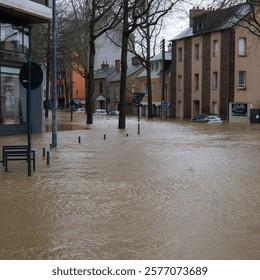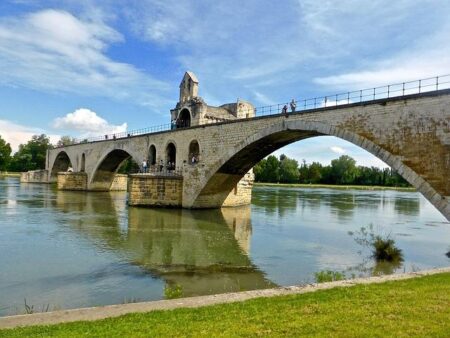Rennes Hit by Worst Floods in 40 Years as Storm Herminia Strikes France
Rennes, the capital of Brittany, is reeling from its worst flooding crisis in four decades as Storm Herminia unleashes its fury across France. Over the weekend, torrential rains and powerful winds battered the region, submerging streets and disrupting daily life for thousands of residents. Emergency services have been deployed to assist in rescue operations, as images capture the unprecedented levels of water transforming the vibrant streets of Rennes into a turbulent torrent. This catastrophic event not only raises concerns about the immediate impact on the local community but also sparks discussions on the broader implications of climate change and urban resilience. As authorities scramble to assess the damage and provide relief, the situation remains fluid, with forecasts suggesting that the worst may not yet be over.
Rennes Faces Unprecedented Flooding as Storm Herminia Ravages France
The city of Rennes is grappling with an unprecedented crisis as Storm Herminia unleashes its fury, leading to the most severe flooding the area has experienced in four decades. Rainfall levels have surpassed historical averages, causing rivers to overflow their banks and inundating city streets. Emergency services have been working tirelessly to assist affected residents, with many forced to evacuate their homes. Road closures and disruptions in public transport have compounded the challenges faced by local authorities, further complicating rescue and recovery operations. Current estimates suggest that over 1,500 homes could be impacted by the relentless deluge.
Authorities are urging residents to remain vigilant as the storm shows no signs of abating. Key measures being implemented include:
- Emergency evacuations: Identifying vulnerable communities and relocating them to safer areas.
- Sandbag deployment: Distributing sandbags to protect properties from rising waters.
- Public alerts: Providing real-time updates and safety instructions through various media channels.
| Impact Type | Estimated Affected |
|---|---|
| Homes | 1,500+ |
| Road Closures | 30 |
| Rescue Operations | 200+ |
The Impact of Climate Change on Weather Patterns and Urban Resilience
The devastating floods in Rennes, marking the worst in four decades, have laid bare the ramifications of shifting weather patterns linked to climate change. As Storm Herminia unleashed torrential rains, rivers overflowed, inundating homes and disrupting daily life. This event underscores a trend where extreme weather phenomena have become alarmingly frequent, crippling urban infrastructures that were not designed to cope with such intensity. Cities worldwide are now grappling with a pressing need to reassess their preparedness for similar catastrophic events.
To strengthen urban resilience, city planners and policymakers must take into account the following strategies:
- Enhancing drainage systems to manage increased water runoff.
- Implementing green infrastructure, such as parks and green roofs, to absorb rainwater.
- Developing early warning systems to alert residents during severe weather.
- Revamping building codes to ensure structures can withstand flooding and storms.
In light of recent events, a coordinated effort is essential to mitigate future risks and safeguard urban communities against the increasing threats posed by climate change.
| Flood Event | Year | Impact |
|---|---|---|
| Storm Herminia | 2023 | Worst floods in 40 years |
| Storm X | 1983 | Major city infrastructure damage |
| Storm Y | 1995 | Significant property loss |
Emergency Response and Preparedness: Lessons Learned from the Floods
The recent floods that devastated Rennes, the worst in four decades, have underscored the critical need for comprehensive emergency response and preparedness strategies. The rapid onset of Storm Herminia caught many off guard, revealing vulnerabilities in local infrastructure and emergency protocols. Key lessons emerged from the chaos that ensued as citizens and emergency services grappled with the rising water levels:
- Proactive Communication: Effective communication systems must be established to keep the public informed prior to, during, and post-disaster events.
- Resource Allocation: Emergency services need adequate resources, including manpower and equipment, to respond swiftly to such unforeseen natural disasters.
- Civic Engagement: Incorporating community input into disaster planning fosters resilience, empowering individuals to take proactive measures.
In analyzing the aftermath of the storm, it is evident that timely data collection and analysis could significantly improve future responses. Local authorities must focus on developing advanced predictive models that can provide real-time updates on weather patterns and flooding potential. A proposed table outlines initial action points derived from the floods that local governments and agencies could consider:
| Action Point | Responsible Agency | Timeline |
|---|---|---|
| Install flood monitoring systems | Local Government | Within 6 months |
| Conduct community workshops | Emergency Services | Quarterly |
| Enhance drainage infrastructure | Public Works | 2 years |
Community Support and Recovery Efforts in the Wake of Natural Disasters
The devastating impact of Storm Herminia has left Rennes grappling with its worst floods in four decades, but amidst the destruction, community spirit is shining through. Local organizations and volunteers have swiftly organized efforts to assist those affected, showcasing the resilience of the city’s inhabitants. Initiatives include:
- Emergency Shelters: Community centers have opened their doors to provide refuge for displaced families.
- Food Drives: Local businesses and residents have come together to donate food and essential supplies, ensuring that no one goes hungry during this crisis.
- Fundraising Events: Charitable events are being organized to raise money for recovery efforts, demonstrating solidarity in a time of need.
As recovery efforts progress, several key organizations are leading the charge in rebuilding the community and restoring normalcy. Collaboration between the municipal government, NGOs, and grassroots activists has made it possible to mobilize resources effectively. The following table outlines the primary organizations involved and their specific contributions:
| Organization | Contribution |
|---|---|
| Rennes Volunteer Network | Coordinating volunteer efforts for cleanup and rebuilding. |
| Local Food Bank | Distributing emergency food supplies to affected families. |
| Rennes City Council | Providing funding for infrastructure repairs and support services. |
In Conclusion
As the waters begin to recede and the cleanup efforts commence, the city of Rennes faces a long road to recovery following the devastating floods triggered by Storm Herminia. With infrastructure heavily damaged and local services stretched thin, the impact of this unprecedented weather event will be felt for months to come. Authorities are urging residents to remain vigilant, emphasizing the importance of community support and resilience in the face of such natural disasters. As the situation unfolds, The Watchers will continue to monitor developments and provide updates on recovery efforts and future preventative measures. The resilience of Rennes and its citizens will be paramount in rebuilding and adapting to the challenges posed by climate change.




